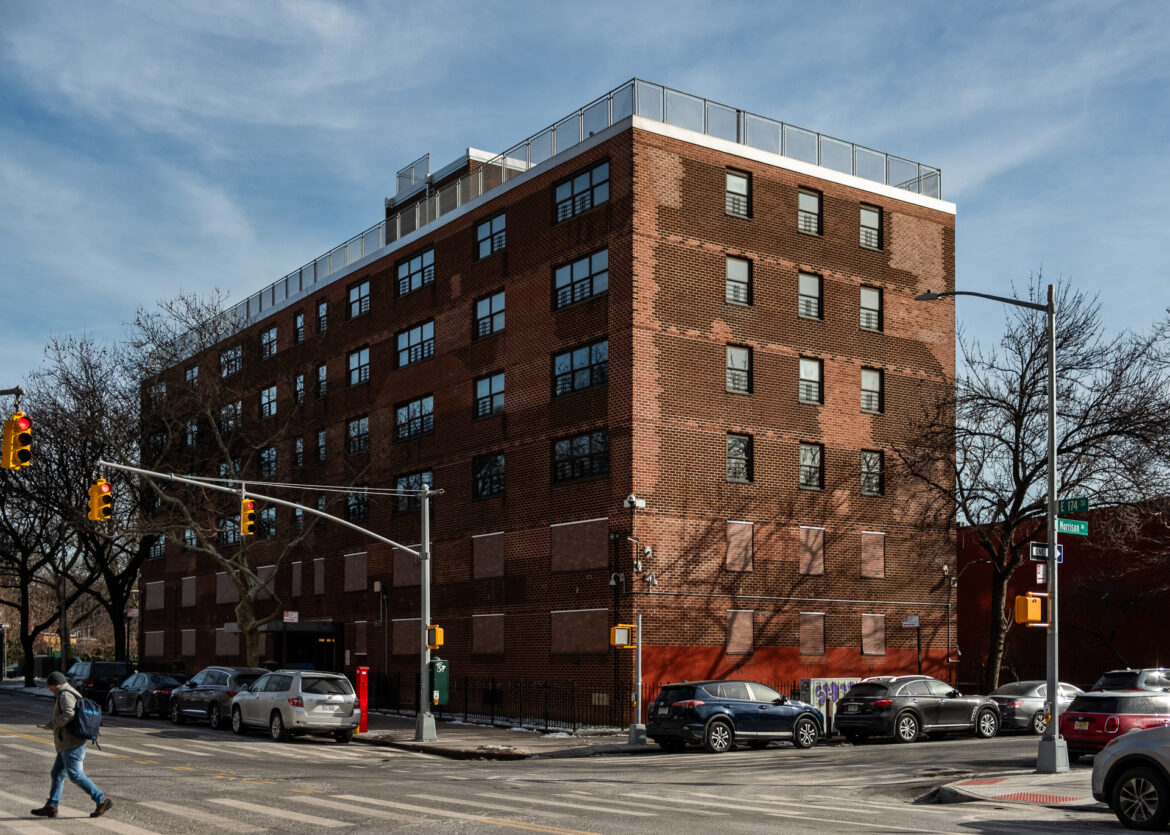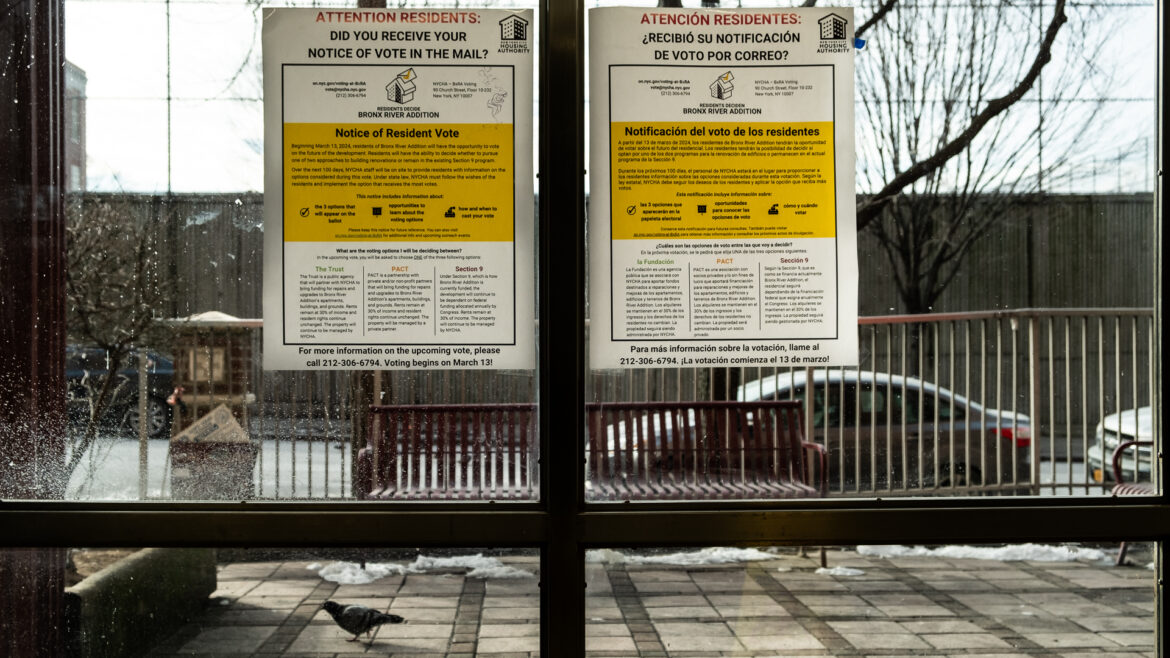For NYCHA tenants, choosing between PACT, Preservation Trust and Section 9 is a decision that can impact the future of their homes. Some seniors from Bronx River Addition haven’t seen theirs in over a year.

Adi Talwar
NYCHA’s Bronx River Addition building which is no longer in use located at 1630-1632 East 174th St. in the Bronx.In less than a month, 199 seniors will have the chance to vote on whether the New York City Housing Authority should bring in private capital, and possibly developers, to upgrade Bronx River Addition—two low-rise buildings in Soundview.
By casting ballots, they’ll be following in the footsteps of tenants at the Nostrand Houses in Brooklyn, a much larger campus where a majority of over 750 voters cast ballots for the novel Public Housing Preservation Trust in December.
But there’s a catch. While all of the Nostrand voters live on the Sheepshead Bay campus, walkable to pre-vote information sessions and ballot boxes, 57 Bronx River households are scattered around the city.
Among them are 60 seniors who once lived in Building 12, which NYCHA deemed uninhabitable in 2022 due to a faulty heating system. Their temporary apartments are located in Manhattan, Brooklyn and elsewhere in the Bronx, NYCHA said, including some apartments in the Bronx River campus adjacent to their old building.
Remote voters will have the option to cast ballots by mail and online for 30 days starting March 13, and won’t necessarily need to travel to the campus for a subsequent 10 days of in-person voting. But tenant advocates say their geographic spread has complicated voter education efforts.
Bronx River Addition has a capital repair need of $66 million, according to NYCHA. In addition to the Trust, a new public entity that can issue bonds to fund repairs, tenants can vote to remain in traditional public housing or join the Permanent Affordability Commitment Together (PACT) program.
Under PACT, NYCHA leases properties to private developers, and outside management companies take over day-to-day operations. While traditional Section 9 public housing has long suffered from federal disinvestment, supporters of the model have raised concerns that private financing is risky.
NYCHA has referenced the inhabitability of Building 12 in its messaging to tenants about the upcoming vote. In a presentation, the authority said it would “continue making limited repairs when possible” if voters opt to remain in traditional public housing. However, rehabilitating Building 12 would be “heavily constrained by funding” in that scenario.
The authority told City Limits that it has had conversations with 91 percent of relocated voters as of Feb. 15. Its Voter Engagement Team, led by three NYCHA staff members, along with additional staff from other departments if needed, has visited these residents.
But Community Voices Heard (CVH), an organization that received funding from U.S. Senator Chuck Schumer to conduct pre-vote outreach, has not been able to reach any of the scattered households.
Instead, CVH started knocking doors in January at Building 11, the Bronx River Addition property that is still occupied, which currently has 146 residents across 133 apartments. NYCHA declined to provide CVH with addresses for the relocated residents citing privacy concerns, according to the organization.
In order for the vote to be valid, at least 20 percent of heads of household must participate. Of the 199 voters, 184 are heads of households, nearly 70 percent of whom live in Building 11, NYCHA said.
This means the fate of the complex could be decided without any participation from remote tenants, though NYCHA told City Limits it is confident that relocated residents will participate. The prior vote at Nostrand Houses saw the majority of ballots cast by mail or online, the authority noted.

Adi Talwar
Fliers inside the lobby of NYCHA’s Bronx River Addition advertising the upcoming vote.Juanita Lewis, the executive director of CVH, said the organization wants to ensure that tenants receive “independent and neutral information” about the options on their ballots.
Even after the Nostrand Houses vote, a raucous tenant meeting in January revealed that many residents still had questions about the Trust model, including the timeline for repairs and what projects NYCHA plans to prioritize.
“We’re concerned because… residents have been relocated and only NYCHA knows how to reach them,” Lewis said in a written statement to City Limits. “Further, this is a seniors development and we don’t know what mobility and health issues might prevent residents from being able to attend information sessions, get their questions answered, or cast a vote.”
Are you a Bronx River Addition tenant? City Limits wants to hear from you about the upcoming vote. Email NYCHA@citylimits.flywheelstaging.com
According to NYCHA, its visits to relocated seniors have taken place throughout the vote’s engagement period, which started in December and will be ongoing until the last day of voting.
NYCHA also said that it has provided a transportation service for relocated tenants to attend four meetings ahead of the vote, two in December and two in January. But only four tenants took them up on the offer.
The housing authority said that it is now focusing on one-on-one engagement at Building 11, as well as among the relocated tenants. Any future events will be posted on their website.
During a recent visit to Building 11, a resident who gave his name as Pablo said he believes NYCHA is doing the best it can on maintenance work, but that he’s interested in the Trust.
“This building inside is falling apart,” he said. “All the apartments and everything… the walls and everything, the pipes are old pipes.”
Another Building 11 tenant who is 75 years old and declined to provide their name was critical of the engagement process.
“There needs to be more information on the voting system in regards to what is going on or what is going to happen,” the tenant of 10 years said. “I don’t understand it correctly.”
For Norma Saunders, the tenant association president at Bronx River and Bronx River Addition, getting relocated residents back to their homes is a priority.
At a Federal Monitor meeting hosted in September at the Bronx River Houses, Saunders told a crowd of NYCHA representatives and tenants that many of the relocated residents did not have relatives with them and that the complex at large was their family.
“That building was their sanctuary…now they’re all over the city,” Saunders said.
Voting at Bronx River Addition will begin on March 13 and end on Apr. 11. The last 10 days of voting, between Apr. 2 and Apr. 11, will take place near Bronx River Addition at a to-be-determined address between 10 a.m. and 7 p.m. on all days.
To reach the reporter behind this story, contact Tatyana@citylimits.flywheelstaging.com. To reach the editor, contact Emma@citylimits.flywheelstaging.com








